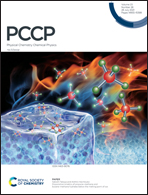The effect of asymmetric external reorganization energy on electron and hole transport in organic semiconductors†
Abstract
Understanding the relationship between charge mobilities and the molecular stacking structures of π-conjugated organic semiconducting materials is essential for their development. In this study, a quantum mechanics (QM)-derived state-specific polarizable force field (SS-PFF) is applied to explicitly estimate the external reorganization energies (λext) during electron transfer (ET) or hole transfer (HT) processes using our recently proposed two-point model (J. Phys. Chem. A, 2018, 122, 8957–8964). Different from the Marcus two-sphere model, the application of the explicit two-point model produces a notably asymmetric λext for ET and HT processes in oligoacene crystals. For the same charge transfer channels, the λext of ET is 7–10 times higher than that of HT, which results in a larger intrinsic hole mobility. This successfully rationalizes why acenes are prone to be p-type conducting materials. Perfluorination can change the polarity of the molecular surface electrostatic potential (ESP). Thus, perfluorination is a possible approach to reduce the external reorganization energies for ET reactions, which can be used to tune the order of λext of ET and HT processes. The two-point model with the SS-PFF, therefore, opens the door to revisit the intrinsic mobilities of electrons and holes in organic semiconductors.



 Please wait while we load your content...
Please wait while we load your content...